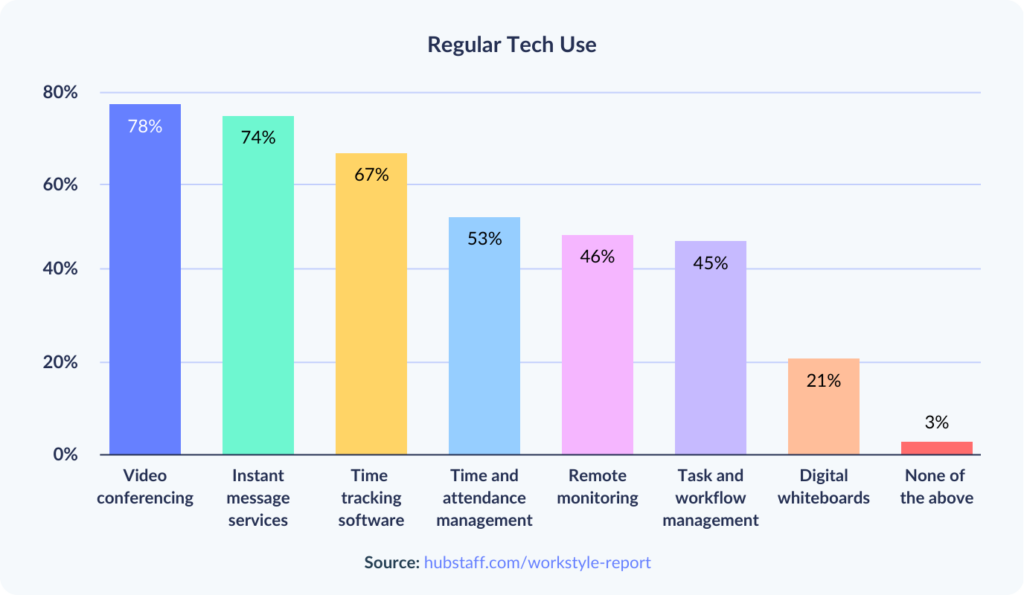We never stop learning how to manage remote workers. Even those who’ve been with us for ages, can be a real challenge. It’s not just about getting the job done—it’s also about staying connected in a remote setting. It’s about employee engagement. Video calls, which used to be helpful, now feel like a chore. And staying in the loop with team meetings and messages from bosses? That’s also become a bit of a hassle.
So, how do we adjust to a remote work environment? Do we need extra effort?
You don’t have to be an expert in psychology to communicate effectively with remote employees. Just make good use of remote work tools and tips. At Hubstaff, we’re all about the remote working environment and finding better ways to manage remote team members. In this guide, we’ll show you the ropes to being a better manager of remote workers.
Boost your team’s efficiency with Hubstaff's productivity tools
Core principles of remote work management
Hey, remember those coffee breaks in the office space with your colleagues? That’s the thing. When we work remotely, it’s easy to lose touch with our remote teammates. But you know what? We think the solution boils down to a few core principles:
- Set expectations
- Create clear communication channels
- Utilize the right tools
- Encourage collaboration and culture-building
- Focus on employee well-being
- Prioritize training and career development
Want to download the full remote management ebook?
Fill out the form below and get the ebook delivered to your inbox.
Strategies for managing remote teams
Managing remote teams starts with setting up remote work policies. Right now, about half of companies have these policies, and many more are considering them. These ground rules also help bring order to the remote work scene and company culture.

1. Establish clear objectives and expectations
Working well from home means having clear goals and knowing your expectations. But those goals aren’t the same for every company; they’re made to fit each one. Plus, different teams and people have their own goals and tasks. A recruiter might aim to make 15 calls a week, a copywriter might write three articles, and a designer might finish three tasks.
But here’s the thing: it’s about more than just hitting those goals. It’s also about handling your workload, understanding challenges, and ensuring your employees stay energized and don’t burnout.
Use messengers, email, and free video conferencing apps to get in touch. For a comprehensive solution tailored to remote work. You can also explore Hubstaff’s workforce management software for a comprehensive solution tailored to remote work.
2. Establish clear communication guidelines
Remote communication can be an adjustment for those who are used to face-to-face communication in an in-office setting. Even with the right remote collaboration tools, communicating across different physical locations, time zones, and cultures can be a challenge.
At Hubstaff, we’ve found that you’ll need to go a step further and articulate how you and your remote teammates will use these channels. That’s why we’ve created a communication manifesto template where you can articulate:
- Use cases for each communication tool
- Appropriate response times
- Task and project management etiquette
3. Utilize tools and technologies for managing remote employees

With the right goals and communication guidelines in place, you can start to build your arsenal of tools. The options are literally endless these days, but we’ve tried to narrow them down to a few that work for remote teams in virtually any industry.
- Google Workspace. Unless you’re a Microsoft person, there’s no rival to the Google Workspace. Gmail, Google Calendar, Docs, Sheets, and Slides are staples of our day-to-day here at Hubstaff and many other companies, so it’s no wonder that almost 85% of the workforce uses it.
- Jira. Jira is a leading project management solution from Atlassian that’s great for developers, marketers, customer support teams, and more. Pre-made templates and integrations with over 3,000 tools make it a great fit for any team.
- Notion. Notion is much more than your basic note-tracking app. Hubstaff uses Notion as our information hub for process documentation, onboarding checklists, guidelines, style guides, and any other resources remote employees need to access.
- Workleap Officevibe. Long before merging with Workleap, Officevibe was a staple in employee engagement. Anonymous surveys, OKRs, goal setting, and one-on-ones are excellent ways to welcome employee feedback and maximize career development opportunities.

4. Encourage team collaboration and culture-building
Remote collaboration tools and communication guidelines are great first steps, but arguably, establishing trust is the most important aspect of managing remote workers. Culture building is crucial for encouraging team collaboration and increasing productivity.
There are a few small things you can do that go a long way in establishing a healthy culture, like:
- Utilize virtual team-building. Team-building exercises aren’t just for in-office teams. If you want to get creative, you can build camaraderie with virtual retreats, happy hours, and coffee chats. We’ve also set up Slack channels to share about our favorite music, TV shows, music, hobbies, and more.
- Establish 360-degree feedback loops. Managers shouldn’t be the only ones allowed to give feedback. Allow each remote worker to weigh in on processes, workloads, and goal-setting to ensure they’re focused on overall company objectives.
- Use tools to gauge employee mental health. Building a productive remote team starts with a strong culture centered around trust. Use surveys, People ops tools, and other technology to give teams an anonymous outlet. Breaking this trust with micromanagement can lead to lead to high turnover.
5. Regularly check on employee well-being
Checking in on a remote employee’s well-being isn’t as easy as it is for in-office employees. Even with anonymous surveys and virtual Stand-ups, managers must be conscious of micromanagement when checking on remote workers.

Fortunately, tools like Hubstaff allow remote team managers a fully customizable glimpse into the day-to-day lives of their remote teams without eroding trust. With Hubstaff, managers can:
- Enable or disable screenshots and adjust their frequency
- See, blur, or remove employee website and app usage
- Gauge productivity with keyboard and mouse usage rates
- Assess burnout with achievement badges for hours, activity hot streaks, and more
- Balance utilization rates, meeting and focus time, and more with the Insights add-on
6. Training and development for remote employees
Do you still think managing remote teams is just about tracking their work hours? There’s more to it than that. It’s also about having a knowledgeable and motivated team. That starts with building a development culture where you can:
- Incentivize growth. Survey employees regularly to identify any interest changes that may lead to career shifts. Then, encourage them to seek internal promotions where possible. Companies that prioritize career development for their employees will see 94% of employees stay longer as a result.
- Champion online learning. 70% of team members prefer online learning and self-paced online courses. Consider providing a remote workforce with an in-house training platform featuring learning tools for content creation, section addition, virtual training, and tracking training effectiveness.
- Celebrate success. Employees are 70% more likely to do better work when they receive recognition for their efforts. At Hubstaff, we try to go the extra mile with our #Hubstars rewards Slack channel.
Beyond encouraging learning, it’s crucial to understand employees’ professional goals and interests in advance and establish timelines and steps for acquiring the right skills.
Survey employees regularly to identify any interest changes that may lead to career shifts. Then, encourage them to seek internal promotions where possible, as the opportunity to learn and grow within an organization is a key driver of employee retention.
Want to download the full remote management ebook?
Fill out the form below and get the ebook delivered to your inbox.
7. Career Growth in a Remote Environment
The remote workforce encounters an unexpected challenge: limited career advancement opportunities.
With less interaction with colleagues and management, employees feel they have fewer chances for recognition and growth. About 42% of remote teams worry about missing out on such opportunities.
To support your employees’ professional growth, address this in team meetings, invite colleagues to other projects, promote collaboration with different teams, and offer increased responsibilities and authority.
Real-world examples of successful remote management
This year, experts predict about 32.6 million Americans to be working remotely. Additionally, eight out of ten employees are anticipated to shift to hybrid or fully remote work. This ongoing trend, which began in 2020, is driven by the benefits it offers employees.

However, the transition to remote or hybrid working presents challenges for organizations, challenges that many companies are successfully overcoming.

Let’s explore three real-life examples and understand their strategies for success.
Managing remote workers: Case studies and success stories
Wondering how to manage a remote team effectively? Explore three examples of teams working remotely and the key lessons your business can glean from them when considering a transition to remote work.
Zapier
Zapier has around 300 employees from over 20 countries, providing a diverse working environment. However, dealing with time zone variations poses challenges. To overcome this, the team plans meetings, deadlines, and communication. Weekly meetings cover project tasks and video call times, requiring creative solutions to manage time differences.
Connecting with the team is facilitated through instant messaging on a communication platform. A helpful tip for managing remote employees across different time zones is to clarify the specifics of GMT or UTC.
Dell
Dell developed and implemented a remote work program called Connected Workplace to enable the transition to remote work. The company emphasizes that having a flexible work program seamlessly integrates remote and flexible work into the organization’s successful business strategy.
Management also maintains flexible schedules to demonstrate confidence in team members’ self-organization ability. Because of its achievements in effectively organizing remote work, the Dell team is recognized as one of the world’s most ethical companies.
Close
The SaaS startup Close is trying out non-business tools to enhance communication within remote teams, aiming for a more personal touch. Traditional tech solutions for managing remote employees have yet to achieve the desired effect in building personal connections among colleagues.
In response, the company has turned to using Snapchat. Even though Snapchat isn’t designed to boost business efficiency, the startup’s representatives highlight that it still does the job well. It allows employees to share enjoyable moments from their workday in a fun way, which then improves team collaboration.
Implementing a remote worker toolkit
The remote worker toolkit is like a digital toolbox for professionals. It includes things like video calls, a versatile project management tool, and cybersecurity measures. These tools help the entire team stay productive and connected while working remotely.
A remote worker toolkit typically includes the following components:
- Communication tools: These include video conferencing tools and messaging applications.
- Project management software: Tools to track tasks and project progress.
- Cybersecurity tools: Including VPN and endpoint security for online safety.
- Remote access technology: Solutions for accessing work systems and files.
- Hardware and accessories: Company-provided laptops and ergonomic accessories.
- Remote worker training and support resources: Online training and IT support channels.
- Time management tools: Time tracking and productivity software.
- Wellness and mental health support: Resources promoting work-life balance and stress management.
Additional essentials for the toolkit may involve Internet connectivity solutions, policy and guidelines documentation, clear guidelines on remote work expectations, virtual team-building activities and meetings (instead of in-person meetings), and feedback and performance evaluation tools.
Utilizing Hubstaff for remote team management
Hubstaff is an all-in-one software used by remote workers, international teams, and freelancers in 15+ industries to get employees on the same page. It helps track time, gauge employee productivity, manage schedules, and automate payroll.
With this software, you can track working hours and productivity of an individual employee, which then contributes to a more profitable business. Key Hubstaff features for efficient remote team management include time tracking, employee timesheets, a daily stand-up tool, project cost management, online invoicing, employee productivity software, and more.
When used correctly, Hubstaff can provide support for remote workers by offering end-to-end solutions and providing greater control over the team, allowing you to work remotely without hassle and keep everyone up to date.
Overcoming common challenges in remote management
Remote work definitely has its perks, offering flexibility in managing both work and free time. But it’s not all smooth sailing; there are challenges, too. Let’s take a closer look at some of these hurdles and how to tackle them.
Addressing Isolation and Lack of Engagement
Ever miss the hustle and bustle of the office? Turns out, some folks do. Working from home can be pretty quiet – no water cooler chats or impromptu meetings. It’s not exactly thrilling, right? But being alone too much can make you feel pretty lonely. Surveys say going from office to fully remote work has caused a 67% spike in folks feeling lonely. This can then lead to burnout and other mental health stuff. Tough, huh?

Source: Zippia
Here’s the deal: to cope with feelings of isolation, why not try virtual hangouts like online parties, meeting cool people, or group training sessions? You can also schedule midweek coffee breaks online to break up the monotony.
And if you’re up for it, why not organize a team building for those who live nearby? You can meet at a cafe, go to the movies, do some volunteering, or even play sports together. It’s a great way to boost morale while also strengthening team bonds.
Navigating time zone differences
Remote work environments let you live by the beach or up in the Arctic while staying connected with your team. Sounds great, right? However, dealing with time zones can be tricky for remote managers. Here’s what you can do: plan ahead for tasks and meetings, agree on one call in advance, and then stick to the schedule. It also helps to make a list of where your team members are based to help coordinate communication more smoothly.
Answering common questions
Looking for more insights into the management of employees working remotely? We’ve got you covered. Here are answers to frequently asked questions about managing remote teams.
What is remote work management?
Remote work management is the strategic coordination of tasks and teams (management style, if you want) when employees work from different locations. It also involves using tools (Google Meet, Slack messages, etc.) and policies to maintain productivity and collaboration in a distributed work environment.
How do you manage remote workers without micromanaging?
Effectively managing remote workers without micromanaging requires building trust, establishing clear expectations, and providing the necessary tools for autonomy. Rather than consistently monitoring the process, the emphasis should be on results. Encourage employees to manage their tasks independently and support self-monitoring. It’s also helpful to avoid excessive and tedious regular meetings and reviews.
Conclusion
Organizing your team’s remote work is simple. With the right approach and technologies, you can establish a seamless workflow where each team member feels valued and contributes significantly to the common goal.
It’s important to note that there’s no one-size-fits-all solution for managing leading remote employees. However, here’s what you can do:
- Build trust and transparency
- Set clear goals and expectations
- Provide the right tools for communicating with the team by determining communication preferences in advance
- Manage time zone differences effectively
- Avoid micromanagement and excessive control (you are not in a traditional office)
- Communicate regularly with your team
- Address common remote work challenges many employees face
- Provide ongoing learning opportunities for employees
- Gain insights from others’ experiences
Understanding the nuances of remote work, recognizing its business potential, and then implementing effective strategies can bring significant benefits to your organization and company culture.Looking for reliable software to manage your remote workforce? Try Hubstaff with a free 14-day trial. Join the 95,000 businesses that have boosted productivity and profits using Hubstaff to manage remote employees. It’s your turn now.
Most popular
The Fundamentals of Employee Goal Setting
Employee goal setting is crucial for reaching broader business goals, but a lot of us struggle to know where to start. American...
Data-Driven Productivity with Hubstaff Insights: Webinar Recap
In our recent webinar, the product team provided a deep overview of the Hubstaff Insights add-on, a powerful productivity measurem...
The Critical Role of Employee Monitoring and Workplace Security
Why do we need employee monitoring and workplace security? Companies had to adapt fast when the world shifted to remote work...
15 Ways to Use AI in the Workforce
Whether through AI-powered project management, strategic planning, or simply automating simple admin work, we’ve seen a dramatic...





